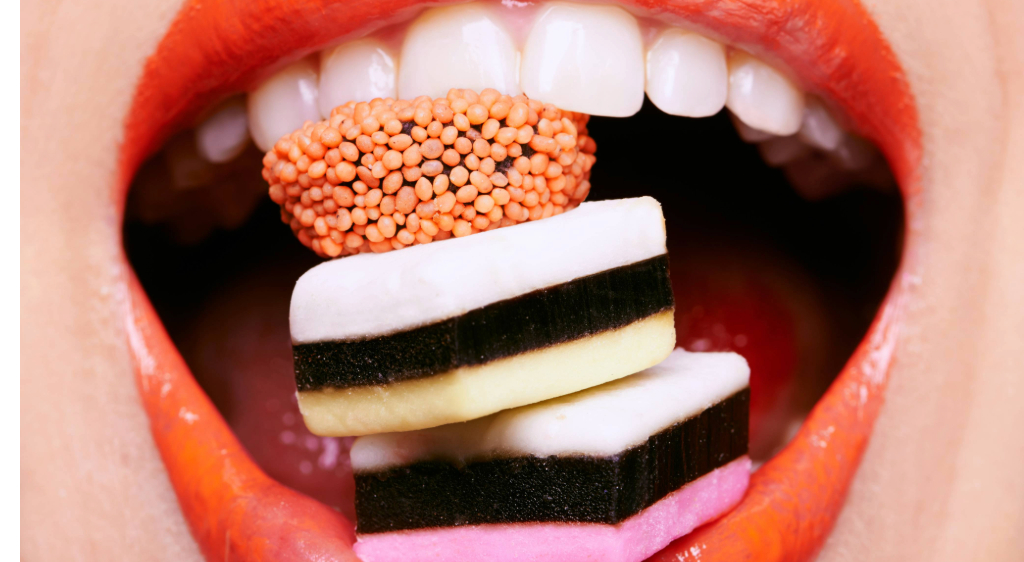Everyone loves a sweet treat, right?
Whether it’s chocolate, cake or your favourite candy, those sugary indulgences bring temporary moments of joy to many people!
But there’s a huge downside that many don’t realize…
The direct connection between those treats and stubborn tartar buildup on your teeth.
While most people already know sugar causes cavities, fewer understand how it contributes to tartar formation both above and below the gumline.
This hardened substance doesn’t just affect your smile’s appearance; it creates a breeding ground for harmful bacteria that can lead to bleeding gums and even tooth loss.
Understanding this sugar-tartar connection gives you power over your dental health.
Today we will explore:
- How sugar transforms into tartar on your teeth
- Which sweet treats are the worst offenders
- Why tartar below your gumline is particularly dangerous
- How TartarEnd® dissolves deposits where brushing can’t reach
If you’ve ever worried about dental health or want to protect your smile while still enjoying occasional treats, you’ll want to read every word of this article.
The Sugar To Tartar Journey
Have you ever wondered what happens when you enjoy that delicious Hershey milk chocolate bar or sip on a Coke?
Well, the journey from sweet treat to tartar buildup follows a predictable path:
Step 1: Sugar Enters Your Mouth
The moment sugar touches your tongue, it begins dissolving in your saliva.
While you’re enjoying the sweet taste, the sugar is spreading throughout your mouth, coating tooth surfaces and seeping into hard-to-reach places.
Step 2: Oral Bacteria Feed on Sugars
Your mouth is home to billions of bacteria, many of which love sugar as much as you do. These microorganisms, particularly Streptococcus mutans, quickly begin consuming the sugar particles left behind.
Step 3: Bacteria Produce Acids & Sticky Biofilm
As bacteria digest sugar, they produce acids and a sticky substance that helps them adhere to your teeth. This sticky layer is plaque – the precursor to tartar. The acids simultaneously begin attacking your tooth enamel, setting the stage for cavities.
Step 4: Untreated Plaque Turns Into Tartar
If plaque isn’t completely removed within 24-72 hours, it begins to harden. Minerals from your saliva combine with the plaque, creating calcium phosphate crystals that gradually mineralize into tartar. Once this happens, regular brushing can’t remove it.
The Most Concerning Part
What makes this process particularly concerning is how tartar forms below the gum line, where it’s practically invisible but causes significant damage.
These hidden deposits irritate the gum tissue, creating pockets that deepen over time and can eventually lead to tooth loss if left untreated.
The Types of Sugar That Contribute Most to Tartar
Not all sugary foods impact your teeth equally. Some are particularly problematic:
- Refined sugars are the worst offenders. Foods containing white sugar, high fructose corn syrup, and other processed sweeteners provide the perfect fuel for tartar-forming bacteria.
- Hidden sugars lurk in many unexpected places. Sauces, dressings, bread, and even “healthy” foods like granola or fruit yogurt often contain added sugars that contribute to tartar formation.
- Sticky sugary foods pose a special threat. Caramels, gummy candies, dried fruits, and similar treats adhere to teeth longer, giving bacteria extended time to feed and produce plaque.
Frequency Over Quantity
The frequency of sugar consumption often matters more than quantity. Constantly sipping sugary drinks or snacking on sweets throughout the day creates an ongoing acid attack that never gives your mouth a chance to recover.
The Science Behind Sugar & Oral Bacteria
Understanding the science helps explain why sugar is so problematic for tartar formation. Your mouth contains a complex ecosystem of over 700 bacterial species – collectively known as the oral microbiome.
What Happens When Sugar Enters Your Mouth?
When you consume sugar, bacteria like Streptococcus mutans and Streptococcus sobrinus metabolize it rapidly, producing lactic acid as a byproduct. This acid lowers the pH in your mouth, creating an acidic environment that:
- Damages tooth enamel
- Creates ideal conditions for plaque formation
- Sets the stage for mineralization processes that lead to tartar
The Protective Shield of Plaque
As plaque forms, it creates protected environments where bacteria can thrive undisturbed. Within these biofilms, bacteria:
- Communicate with each other
- Become more resistant to removal
- Establish permanent colonies
The longer plaque remains on your teeth, the more it mineralizes into hardened tartar.
The Timing of Acid Attacks
Research has shown that mouth pH typically drops within minutes after sugar consumption, remaining acidic for up to 30 minutes. This means:
With frequent sugar exposure throughout the day, your mouth spends more time in this acidic state, accelerating both tartar formation and gum inflammation.
The Dangerous Pocket Affect
Particularly concerning is how tartar formation affects gum pocket depths. As tartar builds up along and below the gumline, it pushes gum tissue away from teeth, creating deeper pockets. These pockets then:
- Trap more bacteria
- Collect additional food particles
- Continue the cycle of inflammation
- Lead to progressive gum disease
This creates a vicious cycle that becomes increasingly difficult to break without specialized products like TartarEnd®.
Effective Solutions for Tartar Removal & Prevention
While reducing sugar intake is important, established tartar requires more than just dietary changes. Once tartar has formed, traditional brushing alone can’t remove it.
This is where TartarEnd® makes a crucial difference. Unlike ordinary toothpastes that focus primarily on cleaning tooth surfaces, TartarEnd® is specifically formulated to dissolve tartar deposits both above and below the gumline.
The unique formula works by breaking down the mineral structure of tartar, making it easier to remove during brushing. What sets TartarEnd® apart is its ability to penetrate below the gumline, addressing the hidden tartar that causes the most significant oral health problems.
Studies have shown that with consistent use of TartarEnd®, users typically experience:
- Reduced bleeding gums within two weeks
- Decreased gum pocket depths by 2-3mm within a few months
- Less visible tartar buildup on teeth
- Improved overall gum health
The effectiveness of TartarEnd® is significantly enhanced when used with a high-frequency sonic toothbrush, such as the Philips Sonicare Series 4100. The rapid vibrations (31,000 per minute) help drive the active ingredients deep below the gum line, where they can work on dissolving stubborn tartar deposits that regular brushing can’t reach.
Maximizing Your Results With TartarEnd
To get the best results from TartarEnd®, follow these guidelines:
- Use TartarEnd® twice daily, brushing for a full two minutes each time.
- Pay special attention to the gumline, where tartar tends to accumulate.
- Use a high-frequency sonic toothbrush for maximum effectiveness.
- Be consistent – improvements in gum health typically begin within two weeks, but continued use is necessary for long-term benefits.
- Expect to see gradual improvements in gum pocket depths over several months.
Many users report seeing significant improvements in their oral health after consistent use of TartarEnd®.
As one customer testimonial notes:
“My hygienist got done with my cleaning in half the usual time. I bought TartarEnd toothpaste after my last cleaning six months ago. And I’ve had problems with tartar and bleeding gums my entire life. It’s better than regular toothpaste with my SonicCare, BY FAR.”
The cost-effectiveness of TartarEnd® is also worth noting. While professional dental cleanings are essential, reducing tartar buildup between visits can potentially decrease the need for deep cleanings and more invasive procedures.
Being Aware of Sugar Consumption for a Healthier Smile
The connection between sugar consumption and tartar buildup is clear, but you don’t have to give up all sweet treats to maintain good oral health. By understanding how sugar contributes to tartar formation and taking proactive steps with products like TartarEnd®, you can enjoy better gum health and fewer dental problems.
Unlike traditional toothpastes that can’t address established tartar, TartarEnd® is specifically designed to dissolve these stubborn deposits, even below the gumline where they cause the most damage.
Combined with smart dietary choices and good oral hygiene habits, TartarEnd® offers an effective solution for managing tartar buildup.






